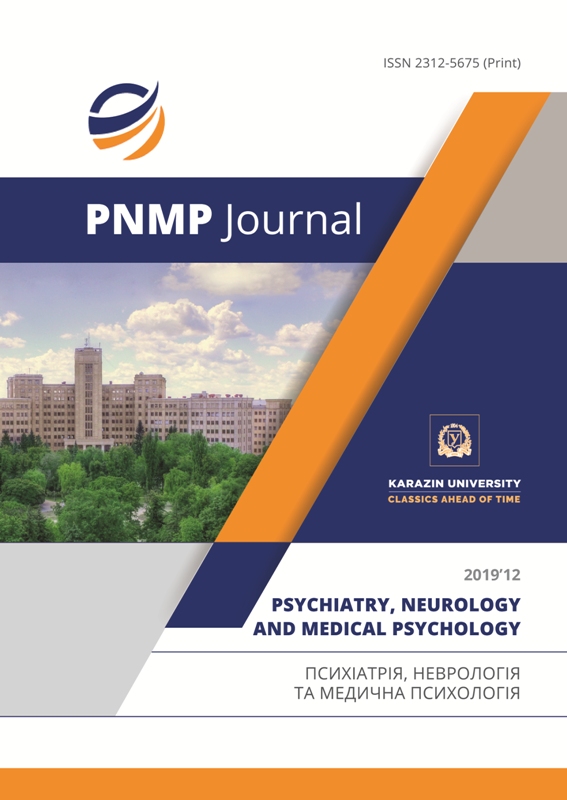Психоэмоциональные реакции на этапе клинически изолированного синдрома рассеянного склероза
Abstract
A prospective study of functional disability and its relationship to the emotional response of a patient to the diagnosis of 30 patients with clinically isolated syndrome (CIS) of Multiple Sclerosis (MS) was performed. The aim of the study was to evaluate the typical emotional reactions in patients with CIS MS and to determine their impact on patients' functional failure in the future. The study was conducted in three stages. In the first stage, before the infusion of methylprednisolone, an emotional response and a degree of functional failure were assessed. Evaluation of the reliability of emotional emotional reaction was performed after 7 days. Re-evaluation of psycho-emotional response and functional disability was performed during recurent MS attack. A total of 30 patients were included in the study, with an average age of 32.07 ± 8.54 years, including 27 women and 3 men. The most frequent emotional reactions were found to be anxiety (60%), shock reaction (16.56%) of patients, categorical denial of diagnosis (13.33%). Relief was less frequent — 6.67% and sorrow in 3.33% of patients. The reliability of the emotional response was re-evaluated after 7 days (Cronbach's α 0.993). The time interval from the moment of CIS MS to the second attack and diagnosis of MS was 6.33 ± 3.467 months. The EDSS score at the time of the second attack was 2.92 ± 0.081 points. A one-way ANOVA procedure was also used for the multivariable analysis to establish the statistical difference of the EDSS score for different levels of the Reaction score. A statistically significant correlation was established between the response values and the Expanded Disability Status Test (EDSS) total score at P <0.01, as well as the EDSS score at the second clinical attack. It was found that the emotional background of the patient influences the prognosis and functional failure in the dynamics.
Downloads
References
Coclitu Catalina, Cris S, Constantinescu CS, Tanasescu Radu. The future of multiple sclerosis treatments. Expert Review of Neurotherapeutics. 2016; vol 16, № 12: pp 1341–56. DOI: 10.1080/14737175.2016.1243056
Kobelt G, Thompson A, Berg J, et al. New insights into the burden and costs of multiple sclerosis in Europe. Multiple Sclerosis. 2017; vol 23, № 8, pp 1123–1136. DOI: 10.1177/1352458517694432
Lublin FD, Reingold CS. Defining the clinical course of multiple sclerosis: results of an international survey. National Multiple Sclerosis Society (USA) Advisory Committee on Clinical Trials of New Agents in Multiple Sclerosis. Neurology. Apr 1996;(46): pp 907–911. DOI: 10.1212/WNL.46.4.907
Fisniku LK, Brex PA, Altmann DR, Miszkiel KA, Benton CE, Lanyon R, Thompson AJ, Miller DH, et al. Disability and T2 MRI lesions: a 20-year follow-up of patients with relapse onset of multiple sclerosis. Brain. March 2008;131(3): pp 808–817. https://doi.org/10.1093/brain/awm329
Bermel RA, Bakshi R. The measurement and clinical relevance of brain atrophy in multiple sclerosis. Lancet Neurol. Feb 2006;5(2): pp 158-70.
Amato MP, Ponziani G, Siracusa G, Sorbi S. Cognitive dysfunction in early-onset multiple sclerosis: a reappraisal after 10 years. Archives of Neurology. 2001;58(10): pp 1602–1606. https://doi.org/10.1001/archneur.58.10.1602
Amato MP, Hakiki B, Goretti B, Rossi F, Stromillo ML, Giorg A, et al. Association of MRI metrics and cognitive impairment in radiologically isolated syndromes. Neurology. Jan 2012;78(5): pp 309 –314. DOI: 10.1212/WNL.0b013e31824528c9
Zivadinov R, Sepcic J, Nasuelli D, et al. A longitudinal study of brain atrophy and cognitive disturbances in the early phase of relapsing-remitting multiple sclerosis. Journal of Neurology, Neurosurgery and Psychiatry. 2001;70: pp 773-780.
Solaro C, Gamberini G, Masuccio FG. Depression in multiple sclerosis: epidemiology, aetiology, diagnosis and treatment. CNS drugs. Feb 2018;32(2): pp 117-133. DOI: 10.1007/s40263-018-0489-5.
Anhoque CF, Domingues SC, Carvalho T, Teixeira AL, Domingues RB. Anxiety and depressive symptoms in clinically isolated syndrome and multiple sclerosis. Arquivos de Neuro-Psiquiatria. Dec 2011;69(6): pp 882-886.
Pucak ML, Carroll KA, Kerr DA, Kaplin AI. Neuropsychiatric manifestations of depression in multiple sclerosis: neuroinflammatory, neuroendocrine and neurotrophic mechanisms in the pathogenesis of immune-mediated depression. Dialogues in Clin Neuroscience. 2007;9(2): pp 125–139.
Rintala A, Matcham F, Radaelli M, et al. Emotional outcomes in clinically isolated syndrome and early phase multiple sclerosis: a systematic review and meta-analysis. Journal of Psychosomatic Research. 2019;(124): p 109761.
Fallahi-Khoshknab M, Ghafari S, Nourozi K, Mohammadi E. Confronting the diagnosis of multiple sclerosis: a qualitative study of patient experiences. Journal of Nursing Research. Dec 2014;22(4): pp 275-282. DOI: 10.1097/jnr.0000000000000058.
Leahy T, Elseed M, Counihan TJ. Clinically isolated syndromes or clinically isolated patients? A patient and clinician perspective on the utility of CIS as a diagnosis. Multiple Sclerosis and Related Disorders. Oct 2017;17: pp 249-255. DOI: 10.1016/j.msard.2017.08.015.
Kalb Rosalind, Reitman Nancy. Multiple sclerosis: a model of psychosocial support 5th edition. 2012.
Polman CH, Reingold SC, Banwell B, Clanet M, Cohen JA, Filippi M, Diagnostic criteria for multiple sclerosis: 2010 revisions to the McDonald criteria. Annals of Neurology Feb 2011;69(2): pp 292-302. DOI:10.1002/ana.22366.
Kurtzke JF. Rating neurologic impairment in multiple sclerosis: an expanded disability status scale (EDSS). Neurology. Nov 1983;33(11): pp 1444-52.
Hreben NF. Psychological tests for professionals. Minsk: Modern. Shk., 2007 [In Russ.]

